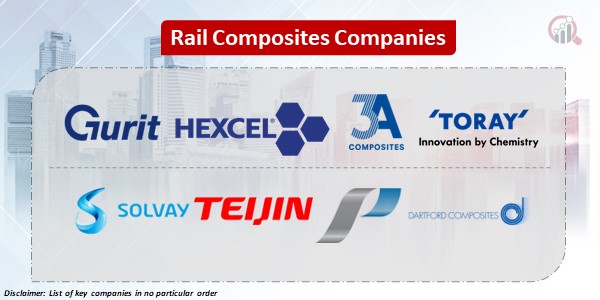Top Industry Leaders in the Rail Composites Market

Rail Composites Market
The Rail Composites Market focuses on the use of composite materials in railway applications to improve performance and reduce weight. Composites are used in the construction of railcar bodies, interiors, and track components, offering benefits like corrosion resistance, high strength-to-weight ratio, and reduced maintenance costs. This market is driven by the demand for energy-efficient and high-speed trains. Innovations in composite materials are crucial for the development of modern rail systems.
Market Leaders and Strategies:
The rail composites market is a mix of established players and emerging ones. Here are some key players and their strategies:
-
Hexcel Corporation: A global leader, Hexcel focuses on carbon fiber composites for lightweight rail structures and interior components. They leverage their strong presence in the aerospace industry to translate knowledge and technology to rail applications. (January 2024) Hexcel announced a collaboration with a major European train manufacturer to develop next-generation lightweight rail car bodies.
-
Solvay SA: Another major player, Solvay offers a wide range of composite solutions, including epoxy resins and prepregs. They focus on R&D to develop fire-retardant and lightweight composite materials specifically for rail interiors. (March 2024) Solvay unveiled a new flame-retardant composite material ideal for high-speed train interiors, enhancing passenger safety.
-
DowDuPont Inc.: This conglomerate provides a variety of composite materials and technologies for the rail industry. They emphasize solutions for exterior components like car bodies and underframes, targeting weight reduction and durability. (May 2024) DowDuPont partnered with a Chinese railcar manufacturer to develop a new composite underframe solution for high-speed trains, aiming to improve efficiency and ride quality.
-
SGL Carbon SE: A specialist in carbon fibers and composites, SGL Carbon caters to the rail industry with lightweight solutions for passenger coaches and freight wagons. They prioritize a sustainable approach, focusing on recyclable composite materials. (February 2024) SGL Carbon announced the development of a new bio-based resin system for rail composites, promoting environmental consciousness in the industry.
-
China National Building Material Group Co., Ltd. (CNBM): A prominent player in the Asia Pacific region, CNBM offers a range of composite solutions for various rail applications. They capitalize on their strong domestic market presence and cost-effective production capabilities. (April 2024) CNBM secured a major contract to supply composite interior components for a new metro line in a major Chinese city, showcasing their regional dominance.
Factors Influencing Market Share:
Several factors influence market share in the rail composites market:
-
Product Portfolio and Innovation: Companies with a diverse portfolio of composite materials, including advanced fibers and resins, catering to various rail applications, gain an edge. Continuous innovation in lightweight, fire-retardant, and sustainable solutions is crucial.
-
Manufacturing Capabilities and Cost-Effectiveness: Efficient production processes, economies of scale, and access to raw materials at competitive prices play a significant role. Balancing quality with cost is essential for market share.
-
Geographical Presence and Regional Regulations: Having a global presence allows companies to cater to diverse rail markets and navigate regional regulations specific to fire safety, material standards, and environmental sustainability.
-
Customer Relationships and Aftermarket Support: Strong ties with major rail manufacturers and reliable after-sales support for composite components are crucial for market share.
Key Companies in the Rail Composites market include
- Gurit Holdings AG (Switzerland)
- Hexcel Corporation (US)
- 3A Composites (Switzerland)
- Toray Industries, Inc. (Japan)
- Solvay (Belgium)
- Teijin Limited (Japan)
- Premier Composite Technologies (UAE)
- Others












